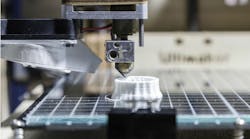The Future of Advanced Manufacturing: Design for 3D Printing and Implementation of Digital Factories
If the global engineering and manufacturing community plans to keep unlocking the full potential of industrial 3D printing, together they will have to keep rethinking the fundamentals of design engineering and digital factories of the future.
The Global 3D printing community has grown exponentially since it was invented in 1983 by Charles Hull. The industry has established industrial verticals like aerospace and medical due to major adoption from several leading organizations to satisfy complex needs. Companies that utilize 3D printing are looking to lightweight parts, to create new channels for thermal heat conductivity, which explore new material mechanical properties.
We are surrounded by 3D printing every day, and most of us have no idea. Your neighbor can walk past you with a custom 3D-printed knee replacement. The cab you take to work may have 3D-printed pulley mechanisms powering your trip. The planes we board might have a 3D-printed fuel nozzle powering the flight.
The evolution of this technology is now helping power the world of manufacturing, creating new jobs, and increasing innovation across the globe. It promotes sustainability, efficiency and innovation.
Companies Are Embracing Complexity of Design
In so many ways, 3D printing’s history as a rapid prototyping technology has led to a major bias in machines, tools and methods, which focus on trying to simplify the process of moving from design to part production. Currently, more than 60% of 3D-printed parts are printed for rapid prototypes.
Focusing so intensely on rapid prototyping has limited the tools engineers need to develop a deeper understanding of these technologies. Major software companies like Siemens, Autodesk and Dassault Systemes are racing to create in-depth 3D design and engineer tools to unlock the full potentials of 3D printing. Software design and simulation tools like Netfabb and Materialise will allow engineers to gain a clearer understanding of the technology and maximize its capabilities for series part production.
To date, we have seen that the depth of control that is possible with 3D printing as it relates to metal part production. The benefits are much greater than most traditional manufacturing processes. The complexity that additive manufacturing affords for the production of metal parts isn’t just around the shape of the part, but also the material it’s constructed from.
For example, laser sintering is one additive technology that has established itself as a viable solution for series production of metal parts. It uses a very fine laser or an electron beam to scan across a bed of powder that is deposited in layers, melting specific regions to form the part. In the production of a typical part, the laser can create millions of exposures — every single one of which could be individually addressable, allowing for far greater design complexity and control.
Navigating Complex Design
Additive manufacturing requires a completely different approach to the current methodology that almost every company has implemented for the design and manufacturing of parts. These traditional organizations that make the economic decision to invest and adopt 3D printing into their ecosystem often overlook the material process, and it becomes a second thought during the design process.
In order to maximize and understand the freedom that 3D printing allows when utilizing new materials, industrial designers, mechanical engineers, and material scientists must work in harmony from the beginning to understand new material properties.
It can be extremely intimidating for companies to rethink and rebuild their workflows and processes as it relates to engineering and manufacturing. More and more, companies are ready to embrace these new workflows, but need advanced technologies to guide and automate the process to ensure successful adoption. The relentless pace of innovation within the industry is in need of responsive technology.
New Thinking = New Tools
Despite its history in traditional manufacturing industries, we are still in the early days of 3D printing with respect to the impact that it can deliver both technologically and conceptually. Accepting new ways of designing parts is the first step. From there, we need technology that can help us deliver on the promise of complexity.
One of the big challenges here is that software really needs to be informed by the entire process of 3D printing, from design to production. Software solutions such as Netfabb, GROW, and Nastran, make this a reality by integrating into 3D design software and 3D printers themselves.
On the design side, solutions like NetFabb and Nastran make it easy for engineers to understand the constraints of 3D printing and optimize designs for the process.
On the manufacturing side, companies like Grow and we here at LINK3D introduce automation into the workflows of application engineers ensuring machines are run at capacity and processes are being documented for successful and secure integration.
Digital Factories of the Future
You might still be asking yourself, what is a digital factory? This term has been loosely used and has many broad definitions. Its comprehensive portfolio of hardware and software products automate and communicate to enable the comprehensive integration of data from development, production and suppliers.
Digital factories are regarded as one of the key components within the organizations that are adopting 3D printing. A report by PWC stated that 91% of industrial companies are investing in digital factories, but only 6% have said they have fully integrated and digested this concept.
Companies that plan to achieve a fully integrated digital factory must invest internally and externally to make this possible. What this means is that companies will have to hire and develop people, manage significant amounts of workflow change, and integrate new software solutions into their workflows.
Benefits of Digital Factories
So what are the benefits of creating a Digital Factory? As companies plan and gain experience with digital manufacturing solutions, they gather a clear picture of the integration timeline and the level of effort requirements — and how long it will take to achieve a return on this investment.
Although most won’t see immediate returns, there are clear returns in the medium. By introducing automation into the workplace, companies can reduce their amount of organizational drag and efficiencies can increase up to 20% per week. Creating better workflow efficiency through automation tools has major benefits for organizations’ bottom line. By adopting automation and AI based on software solutions, companies can speed up their design processes, reduce manufacturing errors with autonomous file repair tools, and increase product speed to market.
Creation of a Digital Factory
Creating a true digital factory connectivity from engineering to manufacturing is essential. It’s a must to enable software and machines and other technologies to communicate based around one central tool.
PWC stated that 29% of companies adopting digital factories have implemented some form of networking technologies that connected software, machines, production management and supply chain.
By using automation and integrated networks, it’s possible for companies to achieve real-time manufacturing. In order for companies to compete in today’s market, it is crucial that they get their product to market in the most efficient way possible.
Roadmap for Success
In order for companies to successfully adopt additive manufacturing and digital success, they should follow a blueprint:
- Map out their digital factory strategy
- Create an initial pilot project
- Define all capabilities that are needed
- Become an expert in data analytics and connectivity
- Transform factories into digital factories
- Integrate into their new or pre-existing digital ecosystems
In Conclusion
As companies become more comfortable with 3D printing, big data, AI and automation, it will drive the demand for more advanced tools to push digital manufacturing to the highest level.
In my opinion, the future of manufacturing is bold, bright, connected and highly efficient. As the world becomes more integrated and data-driven, companies will be able to adopt new technologies at a pace that the world has never seen. Custom design, localized manufacturing and distributed supply chains will drive us into the future. People from all walks of life with an idea will be able to make their dreams into a reality. New and advanced companies will populate at a rapid pace, and their drive to get it done will be more accessible than ever.
It’s been a difficult journey, full of risk, but we now have a path to success. It is up to organizations to adopt these principles and push the ball forward.
Shane Fox is the Co-founder and CEO of LINK3D, which produces automation software that optimizes the industrial 3D printing workflow for enterprises in medical, aerospace, automotive, and energy.




